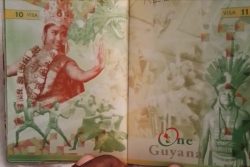(Trinidad Guardian) Acting Police Commissioner Stephen Williams has identified 188 crime “hot spots” across the country. Williams gave the startling statistic yesterday when he appeared before a joint select committee (JSC) in Parliament chaired by Dr James Armstrong. “We use the term ‘hot spot’ loosely in T&T, because wherever there is a concentration of crime we say ‘hot spot,’” Williams said during his appearance.
“But ‘hot spot’ is clearly defined as a small geographical area. So we call Laventille a ‘hot spot,’ but it is not that, it is a large area, so within Laventille we can locate some ‘hot spot’ areas.” Williams said the Police Service had engaged the expertise of Prof Lawrence Sherman, director of the Institute of Criminology of the University of Cambridge, to do a proper scientific analysis of the crime situation. This, he said, had helped them tabulate the number of hot spots.
“At present the work we are doing with Cambridge…as we were exploring violent crime communities, we were able to identify 188 hot spots of violence,” he said. “This is the first time this has been done for a country—to look at the whole country and identify violent crime hot spots.” The acting CoP’s hot-spot figures contrasted dramatically with those given during the state of emergency in 2011. Back then, just under 60 areas were given as hot spots.
Williams did not itemise the 188 hot spots yesterday, but said the locations of the ten police stations which had to deal with the most serious crimes were Chaguanas, San Fernando, Besson Street and Central Police Station in Port-of-Spain, St Joseph, St James, Arima, Scarborough and San Juan. He said for the Police Service to move forward it must be singled out as a professional entity and officers must also be given proper remuneration packages.
The way forward, he added, was also through the use of consistent scientific means. “Over the next two months we will be running a randomised control trial, an experiment at the highest level utilising the input of Prof Lawrence Sherman, who is facilitating training with 200 middle managers,” Williams said.
“A direct follow-up to that training is to make some clear determination of crime and location, and that will allow us not to speak in loose terms when asked specific questions.” He said there must also be scientific knowledge to prove that, thanks to heightened police activities in one area, or through the use of other factors, crime had dropped.
“We see a clear correlation in what we do and the reduction in crime. But to make that determination by way of cause and effect, we need scientific support and that is what we are doing now,” he said. “We are starting a process by utilising the highest level of scientific methods and tests to make those determination.” Committee member and Planning Minister Dr Bhoe Tewarie asked Williams what was needed for the police to achieve sustained control of crime.
Williams said they would need a comprehensive measure which also took into account crime as a social issue, and a broad-based approach of improving communities was also needed. “And social intervention must be clearly targeted, because crime is just one feature within the social domain,” he said. “What we have recognised is that young people between 13 and 35 are the greatest offenders, and it is important for us to change the dynamics of what people refer to as idle hands.”
On vehicle resources, Williams said the police currently had 1, 365 vehicles, of which 349 were not in operation. He said efforts were being made to bring it to a fleet of 1,700 vehicles.








